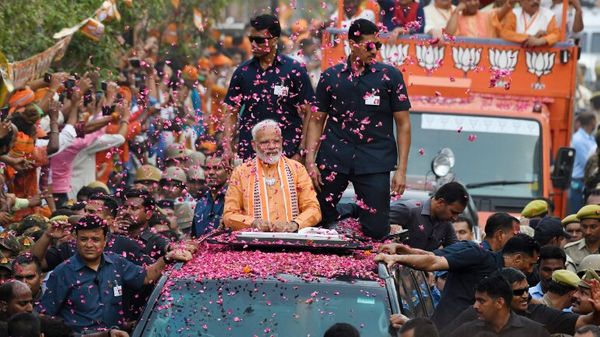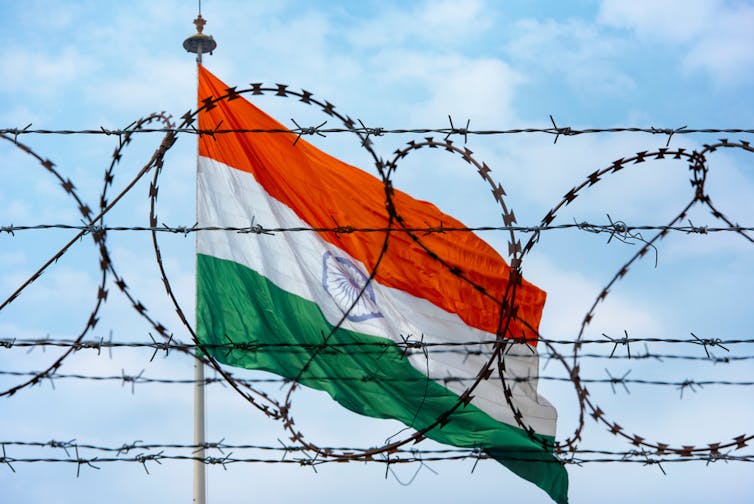
India’s recent election campaign was overshadowed by a suicide bombing in Kashmir, retaliatory air strikes against alleged terrorist targets a few days later, and then an anti-satellite missile test just before voting began.
Perhaps unsurprisingly, then, the contest focused on who was best suited to keep Indians safe: Narendra Modi, who restyled himself as a “chowkidar” (“watchman”), apparently ever alert to threats to the nation, or his main opponent, the untested Rahul Gandhi.
Modi won big, but major national security challenges remain. His government’s record in managing security during his first term was mixed. Overall, it struggled to come to terms with domestic insurgencies, modernising the military, and deterring potential threats from Pakistan and China.
Modi’s government certainly had some successes, above all containing Maoist “Naxalite” violence. At its peak, in 2010, that insurgency affected nearly 40% of the country, mainly in the central and eastern states, and left more than 1,000 people dead. Since then, more intense activity by the security forces and new economic development programmes have greatly reduced the danger. In 2018, 40 people died as result of Naxalite attacks.
The government did less well, however, in Kashmir. In July 2016, unrest flared after Indian security forces killed the prominent separatist Burhan Wani – and dozens died in the rioting that followed. Before and after, there was also an upsurge in terrorist attacks carried out by infiltrators from Pakistani-controlled territory.
In early January 2016, eight Indian soldiers were killed fending off an assault on an airbase, and in mid-September 2016, 23 more died at another military camp.
‘Surgical strikes’
After that last attack, Modi ordered so-called “surgical strikes” across the Line of Control in Kashmir, and Indian special forces destroyed a number of alleged terrorist camps. The strikes – recently dramatised in blockbuster Indian movie, Uri – were intended, in part, to deter further attacks. But whether they did so is unclear. Government figures show a rise in terrorism-related fatalities after 2014, and no obvious dip in 2017 and 2018.
buy Aciphex online Buy Aciphex cheap Aciphex no prescription
Beyond internal security, acquiring new hardware for India’s military also tested the Modi government. The shuffling of the defence portfolio from finance minister Arun Jaitley to the mercurial Manohar Parrikar, then back to Jaitley, and then to Nirmala Sitharaman did not help. Nor did the diminishing defence budget, which shrunk to a mere 1.5% of GDP by the end of Modi’s first term.

As a result, despite some changes to rules concerning procurement and foreign investment in the defence industry, modernisation proved patchy and slow. India finally commissioned its first nuclear-powered ballistic missile submarine under Modi, purchased new French Rafale aircraft – albeit in a controversial deal – and inducted new light fighters and attack helicopters. But other much-needed projects, like the raising of a new Mountain Strike Corps tasked with defending the Sino-Indian border, were postponed.
So, too, were much needed reforms to India’s national security apparatus. It floated, then put off, a decision to create the post of chief of the defence staff, which seasoned analysts think essential to managing inter-service rivalry. It toyed with the idea of publishing a National Security Strategy and tinkered with the National Security Council, but to the frustration of former officials, it did not expand its capacity.
buy Aciphex online Buy Aciphex cheap Aciphex no prescription
Like his immediate predecessors, Modi compensated for these institutional shortcomings through diplomacy. He tried to leverage what he could from strategic partnerships with the US, Israel, Japan, and others – with some success. Arguably, Modi’s greatest achievement during his first term was securing, in 2016, Washington’s designation of India as a “major defence partner”. This bespoke arrangement allows New Delhi to access US military technology normally available only to allies.
Engagement and pushback
At the same time, to manage potential threats from Pakistan and China, Modi oscillated between engagement and pushback, with more mixed results. It remains unclear whether Islamabad will come to the table for meaningful talks any time soon, or whether militant groups operating from its territory have been deterred by India’s recent strikes against them. It is also unclear whether China rates India’s capacity to defend itself any more highly now than it did in 2014, before Modi came to power.
Aside from these challenges, one more will have to be addressed in the months to come. During the campaign, Modi and his political allies faced criticism for politicising not just national security, but also the armed forces.
The prime minister’s call to voters to dedicate their choice to those who carried out the February air strikes was singled out, as was the Uttar Pradesh chief minister’s reference to the armed forces as “Modi ki Sena” (“Modi’s army”).
Repairing relations with officers unhappy with their work being used for political advantage will be a key task for Modi’s next term. Building the national security institutions and modern armed forces India needs will go a long way towards achieving that objective, and fulfilling his promise to serve as the country’s “watchman”.
Ian Hall is the author of Modi and the Reinvention of Indian Foreign Policy Bristol University Press provides funding as a content partner of The Conversation UK
Ian Hall, Deputy Director (Research), Griffith Asia Institute, Griffith University
This article is republished from The Conversation under a Creative Commons license. Read the original article.

